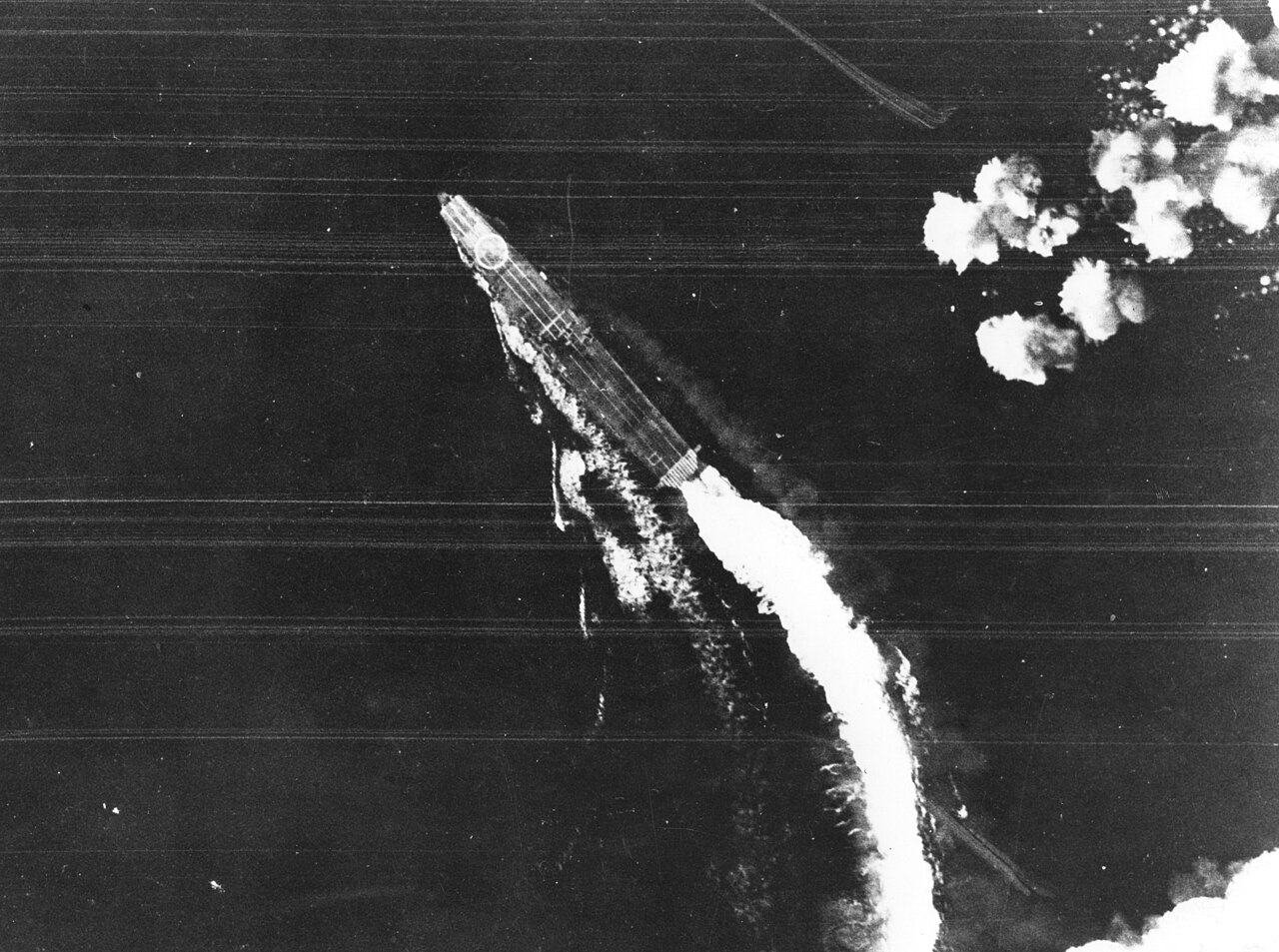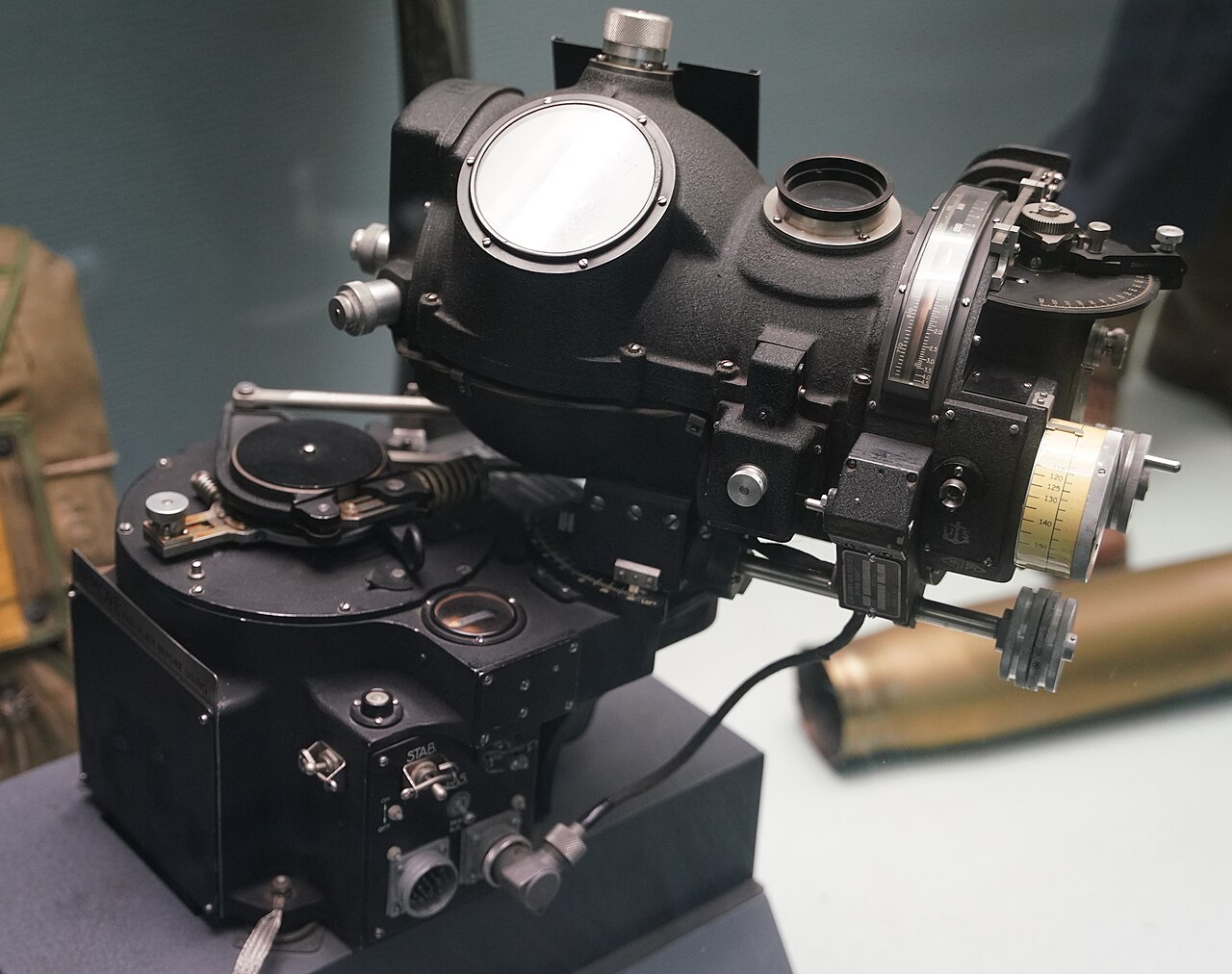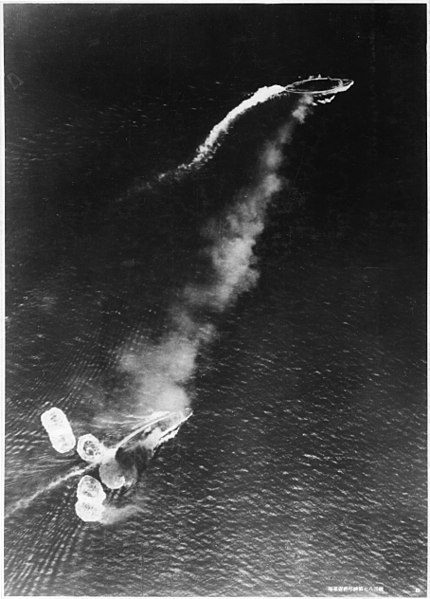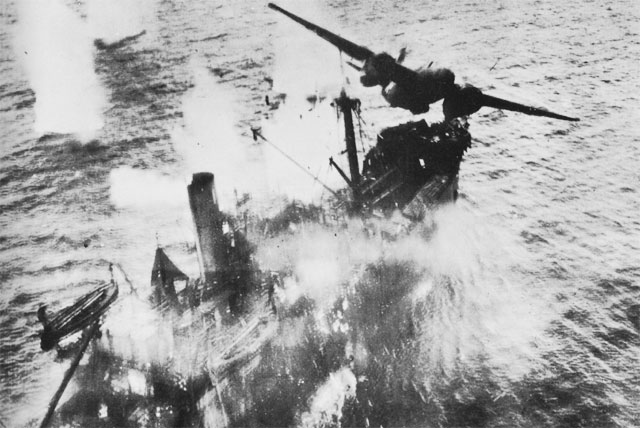Killing surface ships from the air was a major challenge during WWII. A number of different methods were tried, and while I've covered many of the unconventional ones at some length, the conventional methods also deserve attention.

Hiryu under attack by B-17s at Midway
The most basic method was level bombing, flying over the target at altitude and dropping bombs. This had the advantage of staying out of the range of lighter defensive weapons, and tended to be favored by interwar advocates of air power. Even the most optimistic realized that a single bomber wasn't likely to land hits, but the theory was that a reasonably-sized formation could drop enough bombs to land a few critical hits. Making this easier was the fact that high-altitude bombing was by far the most effective way to attack the deck of a battleship. Armor-piercing bombs dropped from high altitude could reach enormous speed on the way down, as shown in this table of altitudes at which various bombs would penetrate decks:1
| Deck Thickness | 2000 lb AP | 1500 lb AP | 1000 lb AP | 500 lb SAP |
|---|---|---|---|---|
| 7" | 9,000 | 13,000 | Immune | Immune |
| 6" | 7,000 | 10,600 | 15,000 | Immune |
| 5" | 5,000 | 7,800 | 10,500 | Immune |
| 4" | 3,000 | 5,000 | 7,000 | 12,000 |
| 3" | 1,000 | 2,500 | 4,000 | 7,000 |
| 2" | - | - | 2,000 | 3,200 |
Of course, the biggest problem with all of this is that bombs don't fall straight down, and figuring out where to drop them was a difficult task, even for stationary targets. In the immediate interwar years, the USN reached out to an engineer named Carl Norden to develop a gyrostabilized bombsight that could in theory allow a steadily-moving ship to be attacked with reasonable confidence. This work led to the famous Norden bombsight, which the USAAF thought would allow it to conduct precision bombing of land targets from high altitude, while the Navy was optimistic enough about it to fit it to torpedo bombers, although this was probably in part due to issues with aircraft torpedoes in the late 30s. Expected errors when bombing from 10,000' were 100 yards in line, with range errors of 140' and 200' deflection errors. Ships would be attacked in formations of 3-9 planes, with a 3-plane formation expected to have a 41% chance of landing at least one hit on a battleship, while a 9-plane formation would have a 83.8% chance. 6 planes would be the standard formation against ships at sea when fighters were the main threat, with 3-plane formations becoming standard if AA fire was the prime consideration. Formations with more than 9 planes were generally considered too unwieldy to work effectively.

A Norden Bombsight
In practice, precision bombing failed to live up to its promise against land targets2 and the main use of the Norden on the torpedo bomber was as an autopilot. One other problem was that the bombsight required the bombardier to hold a steady course for at least 45 seconds before the bombs were dropped to steady the solution down. This gave the defender a window to shoot without worrying about evasive action, and raised the possibility of disrupting an attack by forcing the approaching bombers to dodge and spoiling their aim.
The only notably successful uses of level bombing with unguided bombs3 came in the early days of the Pacific War, when the Japanese managed to land a number of hits on stationary ships during the attack on Pearl Harbor, while a few days later, about half of the bombers that went after Repulse and Prince of Wales attacked in this manner, landing a few hits, although the majority of the damage was done by torpedoes. Soon enough, improved Allied AA kept the bombers too high and too distracted to be effective, and the only other large-scale success of level bombing came in attacks by German Fw 200 Condors on Allied convoys, which had neither particularly strong defenses nor the ability to maneuver freely. Operations also revealed other problems, like the fact that cloud cover could easily disrupt level bombing attacks while leaving torpedo bombers unaffected.

Prince of Wales and Repulse under bombing attack
Also technically falling under the heading of "level bombing" were a variety of tactics developed to deliver conventional bombs from extremely low levels, most famously skip bombing. All of these involved approaching at maximum speed and minimum altitude (50' or less was common) and dropping bombs that would either skip off the water and into the target, or just hit the target directly. After the bombs were away, the plane would generally need to pull up to avoid slamming into the target. The bombs would be fitted with a 4-5 second delay fuze, to allow the aircraft to get clear. This tactic was used with great effect against merchant ships and even lightly-armored warships, most prominently at the Battle of the Bismarck Sea when American and Australian bombers managed to sink 8 of 8 transports and 4 of 8 destroyers in a convoy headed for New Guinea.4 But there were several problems. First, it involved flying straight into the teeth of whatever AA defenses the target had, and successful uses of the tactic usually required coordination with strafing aircraft to suppress flak,5 although at least speed could be kept higher than was typical for torpedo bombers, and the pilot had to steady his course for only a few seconds instead of the 20-30 required for torpedo attack.6 Second, the technique took a great deal of skill to get right, and added the risk of a faulty fuze taking out the plane that had dropped it. Third, it was not particularly effective against armored ships, as the bomb would be stopped by the armor belt, and probably destroyed before the fuze could function. The proposed solution was to make a shallow dive and aim the bomb slightly short of the target, in the hopes of going off in the water alongside and doing underwater damage.7 This was apparently never tested operationally.

An A-20 attacks a Japanese ship at masthead height
All in all, level bombing with unguided bombs was not a particularly good solution to sinking ships at sea. Attacking from high level was effectively useless, while low-level attacks were only practical for lightly-armed and lightly-defended targets. But the most worrying ships had both defenses and armor, and the initial plan for how to deal with them relied on the oldest counter to the battleship, the torpedo.
1 Table from D.K. Brown, Nelson to Vanguard, p.27. ⇑
2 The effectiveness of the bombing campaigns is a hotly-debated issue to this day, and I tend to be fairly positive on it. It wasn't completely useless, and the USAAF's campaign was often reasonably successful, although it obviously didn't win the war single-handedly. ⇑
3 The caveat is necessary because of the German development of guided bombs, which were used quite successfully against Roma and with lesser degrees of success against a number of other ships. ⇑
4 As an indication of how effective this was, heavy bombers dropped 253 bombs during this action from medium altitude, scoring 19 hits and 42 near-misses. Medium bombers dropped 124 from medium altitude (11 hits) and 137 from masthead height (48 hits). ⇑
5 This was largely the reason some B-25 models had solid noses filled with machine guns. ⇑
6 I suspect that the long run-in for torpedoes was to give the gyros time to spin up, but am not sure of this. ⇑

Comments
Was there any interest in saturation ("carpet") bombing with small HE bombs? Particularly against CVs, which would stand a fairly high chance of being mission-killed or otherwise severely inconvenienced by such a bomb, thus the increased probability of hitting at all would be worth it. (Unlike with BBs, where this approach would mostly only cause annoyance, thus if one would be dropping things in their general direction, one would rather play the "big AP" double-or-nothing lottery.)
Perhaps the first picture is showing exactly this, with the features in the top right being bomb splashes (rather than clouds or AA bursts), and the answer being exactly "it didn't work because with the target maneuvering and the inherent accuracy of bombing, the area to be saturated was just too large -- against CVs it's still better than large-AP, just objectively ineffective enough to not be worth bothering with".
To a large extent, that's what they were trying to do. Yes, for attacking a carrier you might use 500 lb bombs instead of 2000 lb bombs, but that only multiplies the number of shots you get by 4 (and it's worth remembering that bomber payloads were pretty low, so even for a really heavy bomber, you're going from 4 bombs to 16), which isn't really enough, particularly when the problem is one of placing the pattern on the target in the first place. And using a bigger formation to get a bigger pattern is probably out because of the difficulty of steering the formation, which wasn't really an issue for land targets.
I was thinking more in the vicinity of 100 lb or less. (What's the smallest unitary antipersonnel bomb they had in service? I know the Germans even developed the "butterfly bomb", clustered 4.4 lb bomblets.) Metaphorical birdshot, but enough to relandscape the deck park, and seemingly that should give the numbers to play with pattern density vs. size.
If, alternatively, the threat of such attack is enough for your adversary to go the British way, sacrificing more than half of aircraft capacity for an armored flight deck, then you already won half a ship.
If you're just trying to suppress AA defense and maybe start fires on parked aircraft, strafing is likely to be more productive than bombs (many more shots, much greater chance of a hit, you can come back and do it again). If you're trying to sink or at least mission-kill the ship, you probably need something big enough to at least hope to do serious damage.
Even "unarmored" aircraft carriers would typically have 1-2" flight decks if only to handle the landing loads of the aircraft. If we take a 100 lb bomb as being roughly equal to a 6" SAP or Common shell, then even falling at terminal velocity is going to be marginal against a 2" deck.
And to sink or even mission-kill an aircraft carrier, you really need to hole the flight deck and get at the hangar. Otherwise you just wreck a few parked planes, and unless you catch them just as they're readying a strike, that's probably not going to amount to much.
One other issue is that the birdshot metaphor doesn't quite work. Sure, a smaller bomb might disperse more on the way down, but not that much more, so by putting more smaller bombs on the plane, you're really making the pattern longer, not wider. And while that can be helpful, it's only one of two dimensions, so your hit rate may not rise as much as you expect.
@bean
Doesn't that depend on how accurate the other dimension is?
Like, for heavy artillery the cross range error is relatively small, but the range error is larger so you have an elliptical hit probability shape. For level bombing it is I assume similar, where the range is aligned to the flight path and the cross range is perpendicular to the flight path. More bombs seems like it would increase the linear density of projectiles in the flight path direction but not do much on the cross-range aspect.
The effectiveness also seems like it would depend on which aspect of the ship you're attacking, and how that balances against time in range for AA fire and how much AA fire the ship can put up in a particular direction. Naively, it seems like an oblique approach from say 30 degrees off the centerline of the ship would maximize hit probability because a perpendicular attack path minimizes the effective width of the ship (i.e., instead of having a 700' long target, you have to get it within a 150' window along the flight path) while a parallel attack would maximize the effective target length, but also increases the risk that everything ends up offset sideways.
Well, and then there's the problem that ships can turn (notice all the pictures of the Japanese carriers at Midway maneuvering in tight circles), which means that "perpendicular approach" can change from moment to moment.
What size of bombs to use, and whether to drop them with the smallest possible spread, or a deliberately larger spread to make them harder to dodge, are separate questions. (Small bombs may prefer a spread at least as large as the target to damage all parts of it, but that much spread seems likely to happen whether you want it to or not.)
i.e. a given number of bombers can drop either N 500lb bombs or 25N 20lb bombs by the same method, and average either Np 500lb hits or 25Np 20lb hits (ignoring any extra spread from the smaller bomb being more affected by wind etc).
Scaling from the 500lb and the 5" shell suggests that a 20lb bomb would have a lethal radius of ~8m. Hence, 25 20lb hits on a typical carrier (~250x30m) would destroy ~50% of the on-flight-deck aircraft/crew/etc (or more if they start fires that spread), and ~15% of the exposed AA gun crew (assuming the structure blocks fragments this size, so only hits in the gun gallery threaten them). Which is not nothing, but is plausibly a bad idea when the same amount of effort would have got you one 500lb hit with a ~1/3 chance of sinking it.
Given that 20-30lb bombs did actually exist, it also seems likely that this would have been thought of at the time. Some 100lb bombs were dropped at Midway, but I don't know how many.
The gyro in a Mk13 torpedo only starts when it is actually dropped, so this seems unlikely.
Surely the oldest counter to the battleship is A Bigger Battleship?
@Basil Marte, In addition to all the other issues that have been raised, most bombers are limited in the number of weapons they can carry as well as by the weight of those weapons. A dive bomber might be able to carry a thousand pound load in the form of a unitary weapon, but only have bomb shackles for a maximum of three weapons - so radically reducing the size of the individual weapons just means you're delivering a lot less BOOM to the target.
I don't guarantee the opening or closing to the same factual standard as the rest of the post. The point I was trying to get across was asymmetric counter, but I couldn't find a good way to word it.
I think the idea for smaller bombs was from a level bomber, which did generally have a lot more flexibility in how it carried its weapons.
Sure, I started with the dive bomber example because they were an extreme case with usually only three hard points. But the B-25, for another example, was volume constrained rather than weight constrained when carrying 23 lb para-frags (maximum of 72, for a total payload of just over 1600 lbs against a nominal maximum load of 3000 lbs).